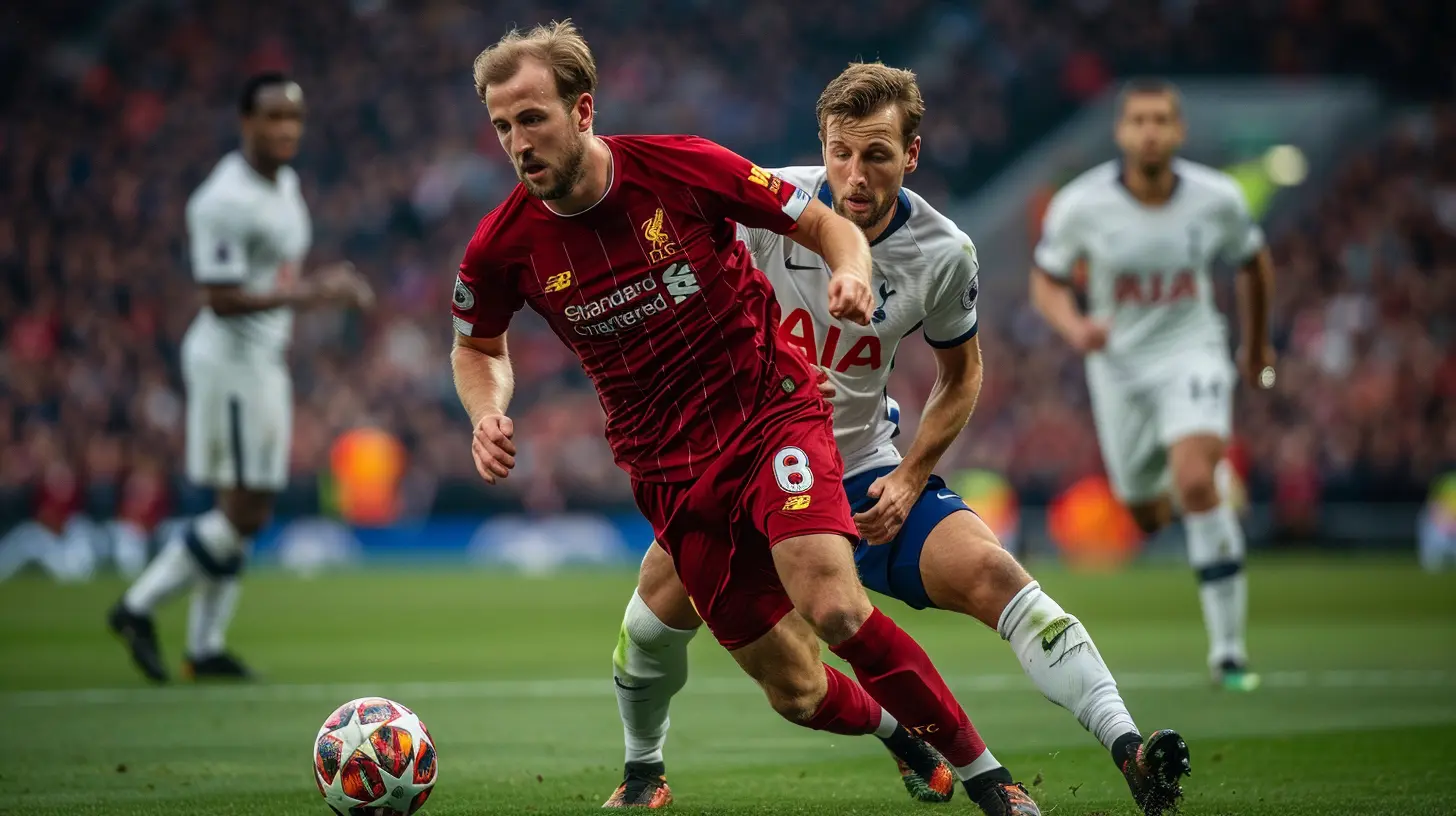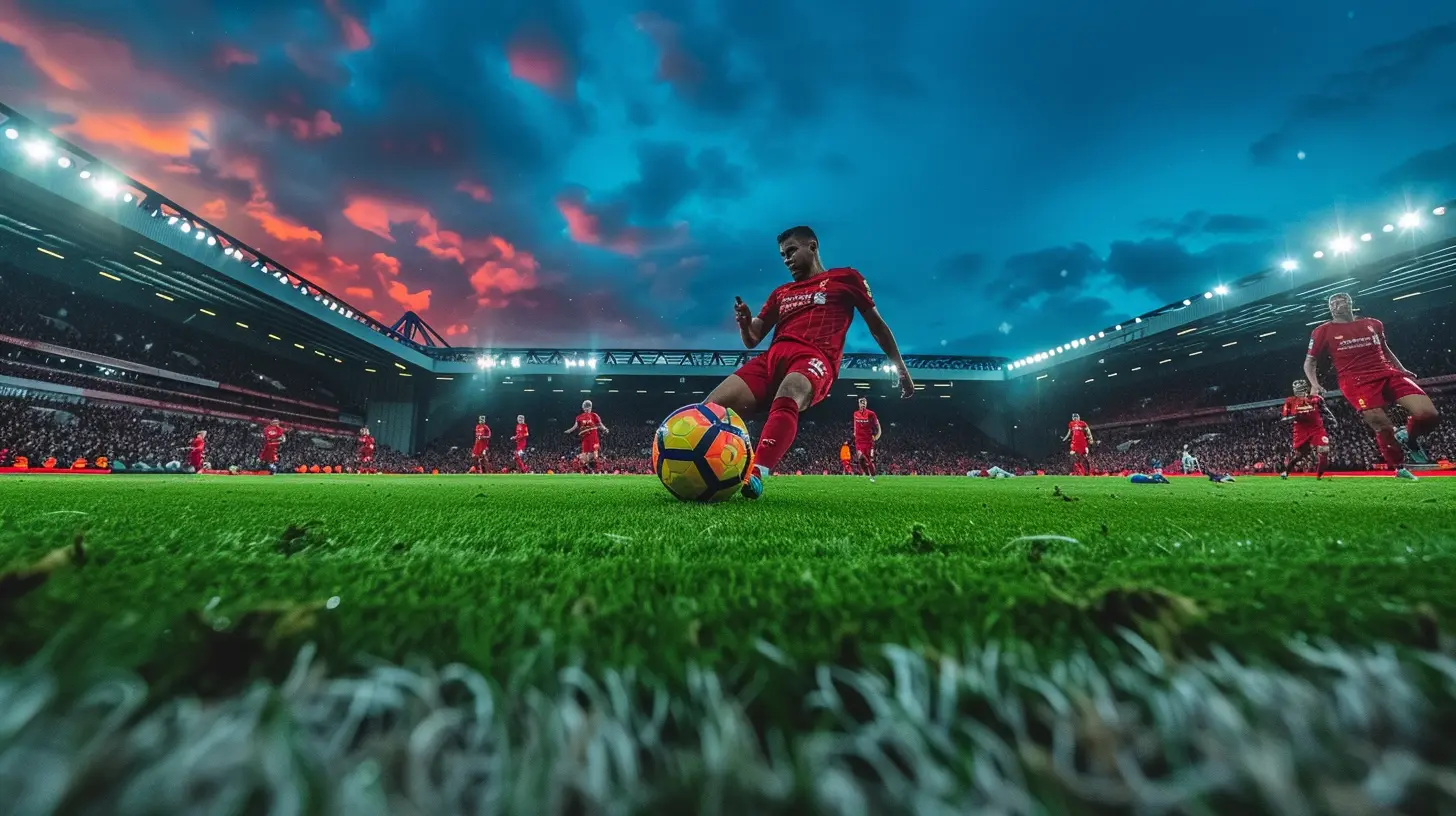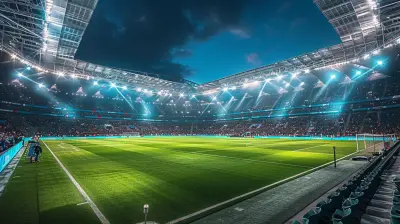The Art of the High Press: A Tactical Breakdown of the Weekends Top Match
9 January 2025
In the modern game, football is about much more than just scoring goals and keeping clean sheets. Tactics have evolved into an essential part of the beautiful game, and one of the most exciting, high-risk strategies to witness is the high press. If you watched this weekend’s top match, you probably noticed how one team used the high press to dominate their opponents. But what exactly is the high press, and why is it such a powerful, yet risky tactic?
In this article, we're going to break down the art of the high press, how it was applied in the weekend's top match, and why it continues to be a popular strategy in today’s football landscape. Buckle up, because we’re diving deep into the world of intense, full-throttle tactical football.

What is the High Press?
Before we dissect the weekend’s match, let’s first understand what we mean by the high press. Simply put, the high press is a defensive tactic where a team applies immediate pressure to the opposition high up the pitch, often around or inside the opponent’s defensive third. The idea is to force the opposition into making mistakes or giving the ball away cheaply, which can lead to quick turnovers and dangerous attacking opportunities.In other words? It’s like playing football with a full-court press in basketball. Instead of sitting back and waiting for the opponent to come to you, you're constantly harassing them, making life uncomfortable for their defenders and midfielders. Sounds fun, right? Well, it is for the team applying the press, but it’s a nightmare for the team being pressed.
Key Components of the High Press
There are several key elements that make the high press work:1. High Defensive Line: The defenders push up the pitch, often playing close to the halfway line, which compresses the space the opposition has to play in. This forces the opposition to either play long balls over the top or risk losing possession in tight spaces.
2. Aggressive Midfield: The midfielders are critical in the high press. They must constantly pressure the opposition's midfielders and defenders, cutting off passing lanes and forcing quick decisions. The goal here is to win possession as high up the pitch as possible.
3. Coordinated Team Effort: The high press isn’t just about individual players running around like headless chickens. It’s a cohesive, collective effort. Every player needs to understand their role, when to press, and how to cover for teammates.
4. Quick Transitions: Once the ball is won, the pressing team looks to transition into attack as quickly as possible. The idea is to catch the opposition off guard while they’re still trying to recover from losing possession.
Now that we’ve got the basics down, let’s talk about how the high press played out in the weekend’s top match.

The High Press in Action: Weekend's Top Match Breakdown
This weekend’s match was a perfect example of the high press being executed to near perfection. Let’s break down how one team deployed the high press to dominate the game.First Half: Setting the Tone Early
From the very first whistle, it was clear that Team A came out with a high press game plan. They weren’t interested in letting Team B settle comfortably into their rhythm. Instead of sitting back and allowing Team B’s defenders to play out from the back, Team A’s forwards, led by their energetic striker, pushed high up the pitch.This early pressure paid dividends. Within the first 10 minutes, Team B’s center-back was forced into a hurried clearance, which went straight to Team A’s midfielder. This resulted in a quick counter-attack, catching Team B off guard. While the resulting shot was saved, it set the tone for what would be a relentless first half of pressing.
Team A’s midfield trio was crucial in this phase. They took turns pressing the ball carrier, while the others cut off passing lanes. It was almost like a well-choreographed dance—each player knew exactly where to be and when to close down the opposition.
Pressing Triggers
One of the most important aspects of the high press is identifying pressing triggers. These are specific moments or situations where the team decides to press aggressively. In this weekend’s match, Team A identified two key triggers:1. When Team B’s goalkeeper had the ball: Team A’s forwards immediately closed down the center-backs and full-backs as soon as the goalkeeper had possession. This cut off easy passing options and forced the keeper to either go long or risk a mistake.
2. Back passes: Whenever Team B played the ball backward, particularly to their defenders, Team A’s midfielders and forwards ramped up the pressure, sensing that Team B was retreating and had fewer forward options.
These pressing triggers were crucial in suffocating Team B’s build-up play. Team B struggled to get out of their own half for large portions of the first 45 minutes.
Second Half: Fatigue and Tactical Adjustments
As the match wore on, the physical demands of the high press began to show. Team A’s midfielders, who had been running relentlessly for the entire first half, started to tire. This is one of the inherent risks of the high press—it’s incredibly demanding on the players. Keeping up that intensity for 90 minutes is no easy feat.Sensing the fatigue, Team A’s coach made a tactical adjustment. Instead of pressing high up the pitch for the entirety of the second half, they began pressing in waves. They would apply intense pressure for 5-10 minute intervals, then drop slightly deeper to conserve energy.
This adjustment worked wonders. During their pressing phases, Team A continued to create turnovers and dangerous chances. In fact, their second goal came from a well-executed high press, where the opposition’s right-back was dispossessed near his own corner flag, leading to a quick cross and a clinical finish.
Risks of the High Press
While the high press is an exciting and effective tactic when done right, it’s not without its risks. In the second half of the match, Team B found some success in exploiting the high press. With Team A’s defenders playing a high line, there was space behind them for quick counter-attacks. On a few occasions, Team B’s winger was able to get in behind the defense with long balls over the top.This is the trade-off of the high press. By pushing your defenders higher up the pitch, you leave yourself vulnerable to counter-attacks. It’s a calculated risk, and in this match, Team A managed to avoid serious damage. But in other matches, this vulnerability can be exploited, leading to costly goals.

Why the High Press Works (When It Works)
So, why is the high press such an effective tactic when executed properly?1. Forces Mistakes: By pressing high up the pitch, the opposition is forced to make quick decisions in dangerous areas. One slip-up, and they’re handing the ball over in a vulnerable position.
2. Cuts Off Build-Up Play: A team that likes to build from the back can struggle against a well-executed high press. The opposition’s defenders and midfielders are under constant pressure, making it difficult to string passes together and move up the pitch.
3. Creates Quick Attacking Opportunities: Winning the ball high up the pitch gives the pressing team an immediate opportunity to attack. With the opposition out of position, it’s easier to create chances and score goals.
4. Psychological Pressure: The high press doesn’t just wear down the legs, it wears down the mind too. Constant pressure can lead to mental fatigue, causing players to make poor decisions or lose confidence.

When the High Press Fails
Of course, there are times when the high press doesn’t work as planned. In this weekend’s match, while Team A was mostly successful, there were moments where Team B found ways to bypass the press. These failures usually happen for a few reasons:1. Lack of Coordination: If one player presses but the others don’t follow suit, gaps open up and the opposition can easily play through the press.
2. Fatigue: The high press requires a tremendous amount of energy. If players aren’t physically prepared or the team tires out, the press becomes less effective.
3. Vulnerable to Long Balls: As mentioned earlier, a high defensive line is a key part of the high press. But this leaves space behind the defense, which can be exploited by teams that play long balls or have quick attackers.
Conclusion: The Fine Line Between Success and Failure
The high press is one of the most exhilarating tactics in football. It requires a combination of physical stamina, tactical intelligence, and teamwork to pull off successfully. In the weekend's top match, we saw how Team A used it to dominate the game, forcing mistakes and creating scoring opportunities.But it’s a double-edged sword. The high press is a high-risk, high-reward strategy. When it works, it can suffocate the opposition and lead to quick goals. When it doesn’t, it can leave a team exposed and vulnerable to counter-attacks.
In the end, the high press is all about balance—knowing when to press, when to drop off, and how to manage the physical demands of the game. From this weekend's match, we saw a masterclass in the art of the high press, but it also served as a reminder of the fine line between success and failure in football tactics.
all images in this post were generated using AI tools
Category:
Game AnalysisAuthor:

Preston Wilkins
Discussion
rate this article
19 comments
Trinity Stevens
The high press demonstrated in this weekend's top match showcased teams' strategic intensity, forcing turnovers and creating scoring opportunities. Analyzing player positioning and coordination highlights the intricacies of this tactic and its growing importance in modern football.
March 31, 2025 at 12:18 PM

Preston Wilkins
Thank you for your insightful comment! The high press truly emphasizes both the tactical depth and intensity of modern football, showcasing how vital teamwork and positioning have become in creating game-changing opportunities.
Callista Flores
What a fascinating exploration of the high press! I'm curious about how different teams adapt their strategies against it. Do you think we’ll see more clubs adopting this tactic as a standard, or will it remain a nuanced approach? Looking forward to more insights on its evolution throughout the season!
March 17, 2025 at 4:01 AM

Preston Wilkins
Thank you! The high press is definitely gaining traction, and I believe we'll see more teams adopt it as standard practice. However, its effectiveness often depends on player capabilities and tactical flexibility, so it may remain nuanced for some. Stay tuned for ongoing insights!
Gisela McLoughlin
Great analysis! The high press truly showcases strategic brilliance; it’s fascinating to see how it influenced the game dynamics.
February 7, 2025 at 1:24 PM

Preston Wilkins
Thank you! I appreciate your insights on the strategic impact of the high press. It's a game-changer!
Patience McNeil
Great insights! The high press truly transformed the game's dynamics!
January 29, 2025 at 8:17 PM

Preston Wilkins
Thank you! I'm glad you found the insights valuable. The high press really does change everything on the pitch!
Roxie Hall
This article brilliantly dissects the high press tactics showcased in this weekend's top match. The analysis highlights how effective pressing can disrupt opponents' play, create scoring opportunities, and ultimately influence the game's outcome. A must-read for tactics enthusiasts!
January 26, 2025 at 9:02 PM

Preston Wilkins
Thank you for your thoughtful feedback! I'm glad you found the analysis insightful and valuable for tactics enthusiasts.
Georgina McMeekin
Great breakdown! The high press really brings the excitement to the game. Can't wait to see how teams continue to evolve this tactic. Keep the insights coming!
January 20, 2025 at 7:20 PM

Preston Wilkins
Thank you! I'm glad you enjoyed the breakdown. It's exciting to see how the high press evolves and shapes the game. More insights coming soon!
Remi Daniels
Great analysis of the high press! It’s fascinating to see how tactical decisions shape the game. The weekend’s match showcased its effectiveness, highlighting the balance between aggression and discipline. Can’t wait for the next showdown!
January 17, 2025 at 9:14 PM

Preston Wilkins
Thank you! I’m glad you enjoyed the analysis. The interplay between aggression and discipline is indeed crucial in executing the high press effectively. Excited for the next match too!
Samantha Acevedo
The high press proved decisive in this weekend's match, showcasing its effectiveness in disrupting opponents’ buildup play. Teams that executed it well controlled the tempo, highlighting its tactical importance in modern football.
January 15, 2025 at 7:36 PM

Preston Wilkins
Thank you for your insightful comment! The high press truly is a game-changer, effectively disrupting opponents and emphasizing its tactical significance in modern football.
Piper Hunter
“Ah, the high press—where teams channel their inner piranhas! It’s not just about chasing shadows; it’s a beautifully chaotic dance of desperation and skill. If you can’t keep up, do us all a favor and stay on the bench. Game on, or game over!”
January 15, 2025 at 4:21 AM

Preston Wilkins
Thanks for your insightful take! The high press truly is a captivating blend of urgency and finesse. Embracing its chaos can lead to thrilling moments on the pitch!
Vesper McPhail
An insightful analysis on the high press! This tactical breakdown highlights how effective pressing can disrupt opposing teams and create scoring opportunities, making it a key strategy in top-level matches. Well done!
January 14, 2025 at 8:34 PM

Preston Wilkins
Thank you! I'm glad you found the analysis insightful. The high press truly is a game-changer in modern football!
Clarissa Yates
Ah yes, the high press—because nothing says “artistry” like chasing exhausted players around a field while pretending you're the next Picasso of soccer tactics!
January 14, 2025 at 5:20 AM

Preston Wilkins
Thanks for your perspective! The high press definitely sparks debate, blending strategy and artistry in unique ways.
Avery McTiernan
Great insights! Love the analysis!
January 13, 2025 at 9:57 PM

Preston Wilkins
Thank you! I'm glad you enjoyed the analysis!
Gabriella Blevins
Great analysis! The high press showcases the beauty of teamwork and strategy in sports. It's exciting to see how effective tactics can completely change the dynamics of a match. Keep it up!
January 13, 2025 at 1:46 PM

Preston Wilkins
Thank you! I'm glad you enjoyed the analysis—teamwork and strategy truly elevate the game. Appreciate your support!
Ursula McWilliams
High press: where players sprint like they’re chasing the ice cream truck—only to find out it’s just a ref with a yellow card!" 🍦⚽️
January 12, 2025 at 8:44 PM

Preston Wilkins
Haha, love that analogy! The high press definitely brings excitement, even if it sometimes leads to unexpected outcomes! 🍦⚽️
Silas McKibben
Great analysis! The high press truly adds an exciting dynamic to the game. It’s fascinating to see how teams adapt tactically. Looking forward to more insights on this evolving strategy!
January 12, 2025 at 12:21 PM

Preston Wilkins
Thank you! I’m glad you enjoyed the analysis. The high press certainly is a game-changer, and I look forward to exploring its evolution further!
Carmen McGarvey
Great analysis! The high press showcases incredible teamwork and strategy. It’s fascinating to see how teams adapt and execute this tactic effectively.
January 11, 2025 at 5:44 AM

Preston Wilkins
Thank you! I'm glad you enjoyed the analysis. The high press truly highlights teamwork and adaptability in modern football.
Kason Nelson
Love how the high press added intensity! Such a thrilling weekend of matches!
January 10, 2025 at 8:35 PM

Preston Wilkins
Thank you! The high press really does elevate the excitement and intensity of the game. Glad you enjoyed the matches!
Kyle McManus
Beautiful analysis! High press truly transforms the game.
January 10, 2025 at 12:48 PM

Preston Wilkins
Thank you! I'm glad you enjoyed the analysis. The high press definitely adds a dynamic element to the game!
Henry McAllister
High pressing: the only time shouting at strangers in fancy kits is considered art! Who knew soccer was just a stylish game of tag?!
January 9, 2025 at 8:23 PM

Preston Wilkins
Soccer’s high press combines strategy and flair, turning the pitch into a dynamic canvas where teamwork and intensity create a truly artistic spectacle!
MORE POSTS

Biomechanics: How Proper Movement Can Prevent Injuries

Understanding the Fear of Failure in Athletes and How to Conquer It

The Importance of Properly Fitting Mouthguards in Contact Sports

Possession vs Counter-Attack: Which Strategy Came Out on Top?

Protective Gear Every Skateboarder Should Own

MMA’s Most Intense Rivalries and Their Impact on the Sport

How Crosses and Headers Defined the Outcome of the Match

How to Avoid Burnout in Young Athletes

How Tactical Flexibility Helped One Team Dominate the Opposition

The Psychology of Comebacks: How Athletes Rebuild After Failure

The Impact of Home Field Advantage: Analyzing the Stats

The Psychology of a Clutch Scorer: What Sets Them Apart